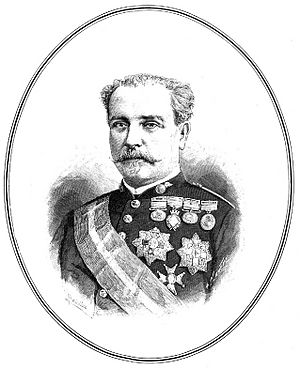Manuel Cassola facts for kids
Quick facts for kids
Manuel Cassola
|
|
|---|---|
 |
|
| Minister of War | |
| In office March 1887 – June 1888 |
|
| Preceded by | Ignacio María del Castillo |
| Succeeded by | Thomás O'Ryan |
| Deputy in Cortes | |
| In office 1876–1890 |
|
| Constituency | Cartagena |
| Personal details | |
| Born | 27 August 1838 Hellín, Spain |
| Died | 10 May 1890 (aged 51) Madrid, Spain |
| Resting place | Cementerio de San Justo |
| Alma mater | Infantry College of Toledo |
| Occupation | Military officer, politician |
| Military service | |
| Rank | Lieutenant General |
| Battles/wars | Santo Domingo Campaign Ten Years' War Third Carlist War Cantonal rebellion |
Manuel Cassola y Fernández (1838–1890) was an important Spanish general and politician. He was known for his military career and for serving as the Minister of War (like a defense minister) for Spain from 1887 to 1889.
Contents
Manuel Cassola's Life Story
Early Years and Military Training
Manuel Cassola was born on August 27, 1838, in Hellín, Spain. His father was a school teacher, and his mother sold clothes.
In December 1852, when he was 14, Manuel joined the Infantry College of Toledo. He worked hard and became a Second lieutenant in June 1856. He experienced his first battle in July 1856 in Madrid. For his bravery, he earned the Cross of St. Ferdinand, 1st class. He was promoted to lieutenant in August 1857.
Adventures in the Americas
Manuel Cassola was sent to Cuba. In 1862, he wanted to join an expedition to Mexico, but he stayed in Cuba instead. Later, he went to Santo Domingo. There, he took part in several military actions, including the occupation of Santiago de los Caballeros. He also helped in operations in San Cristóbal and other places. During this time, he earned the rank of captain.
He also taught Geometry and Topography at the Havana Military Academy. When the Yara insurrection began, starting the Ten Years' War in Cuba, Cassola formed a group of volunteers. He led this group in many battles, such as La Mercedes and Sancti Spíritus. He became ill while fighting and returned to Spain in December 1871. He was a Lieutenant Colonel by then.
Fighting in Spain: Carlist and Cantonal Wars
In December 1872, Manuel Cassola moved to northern Spain. He fought against the Carlist forces in Navarre. He took part in the battle at Lacunza's bridge. He was then promoted to colonel. He continued to fight until he fell ill in May 1873 and returned to Madrid.
He worked as the director of the Artillery Park. He also joined the Army's organizational board. He earned another military honor for his service. Cassola led the Galicia regiment during the siege of Cartagena. He helped until the city surrendered in January 1874.
He then took his regiment to Catalonia and the North. He helped in the Somorrostro battles. He also helped connect the forces of the Marquis of Duero and the Duke of la Torre.
He was promoted to Brigadier general. He led a brigade in Biscay. He surprised the town of Munguía and fought in other areas. He later led another brigade, taking control of Algorta. He also managed military operations in Nocedal and Monte Curendi. He then led a brigade in Guadalajara. He took part in battles in Campillo de Alto Buey and Huélamo. He also helped in the siege of Cantavieja. He moved his brigade to Navarre, occupying Oteiza. In January 1876, he became Commander General of the Biscay division. He helped win battles in Santa Águeda and Elgueta, earning more military awards.
Return to Cuba
In October 1876, Manuel Cassola went back to Cuba. He became the Commander General of the Western Villas. He was in charge of both military and civilian matters in the central part of Cuba. He constantly pursued the rebels. He personally led many important battles and operations. Eventually, the rebels asked for a pause in fighting, which led to a general peace.
Later Life and Political Career
Manuel Cassola was promoted to Lieutenant General on May 9, 1878. In March 1879, he was appointed to lead the Captaincy-General of Granada.
He was elected as a member of the Congress of Deputies (like a parliament) for Cartagena. In August 1883, he became the Director–General of Artillery. In March 1887, he became the Minister of War in a government led by Sagasta.
As Minister of War (from March 1887 to June 1888), Cassola suggested many modernizing reforms for the army. These ideas caused a lot of discussion about defense in Spain. After leaving the government in 1888, he continued to live in Madrid as a deputy for Cartagena.
Manuel Cassola died on May 10, 1890, in Madrid. He was buried the next day at the Sacramental de San Justo.
See also
 In Spanish: Manuel Cassola para niños
In Spanish: Manuel Cassola para niños

